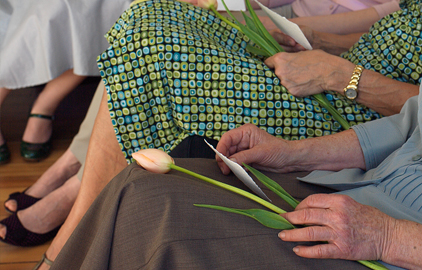There is a growing awareness of the high environmental impact of some of our most common burial practices. The unnatural process of embalming introduces a host of harmful chemicals into the earth, treated and polished tombstones resist bio-degradation, and traditional caskets are made specifically catering to permanency. In effect, our cemeteries become natural dead zones where life will ever have little chance of flourishing. Green burial, thusly, is emerging as a welcome alternative.
What is green burial? How do you conduct a green funeral? Are there green cemeteries, and what kind of cemetery should you look for? This section of SevenPonds will help to answer your questions about this important new death servicing option.
Things to Know:
- A green burial promotes the growth of native trees, shrubs, and wildlife.
- Most green cemeteries encourage the use of environmentally friendly coffins made from cardboard or wicker. A simple cotton shroud is another option.
- An unembalmed body may be buried in most traditional cemeteries, though most green cemeteries specifically prohibit the burial of embalmed bodies.
- You have the right to plan and hold a memorial service or a green funeral without employing a funeral home.
- Unfortunately, not all services, products, and cemeteries that purport themselves to be “green,” are in practice as environmentally sound as they say. Currently the Green Burial Council is the only organization that offers environmental impact accreditation to after-death providers. Check to see if a product, service, or cemetery has been approved by The Green Burial Council. If it hasn’t been, consider contacting an independent third party.
What is green burial?
A green burial is an environmental alternative to a standard burial, intended to minimize the environmental impacts of death and conserve natural resources. In a green burial an unembalmed body decomposes naturally in the earth, and a biodegradable green casket or cloth body shroud takes the place of a traditional coffin. Green burials can take place in traditional cemeteries, specially designated green cemeteries, or even on private land. For more information, see Choosing Green Burial.
Why have a green burial?
Nature takes its course in a green burial. Green burial strives to avoid intrusion into its surroundings; herbicides and pesticides are not used at green cemeteries, vaults or tombstones do not alter the landscape. Green burial is environmentally friendly and will help to preserve natural spaces throughout the United States.
What kind of cemetery should I look for?
There are three different green cemetery classifications: “hybrid burial grounds,” traditional cemeteries that reserve space for green burials, “natural burial grounds,” which exclusively conduct green burials and enforce a wide array of environmental restrictions, and “conservation burial grounds,” which are, basically, natural preserves — a conservation organization works in close partnership with the green burial staff to safeguard native wildlife and plant life. For more information, see Choosing Green Burial. Most "traditional" cemeteries, on the other hand, have few or no trees and have severely damaged their grounds through continued use of herbicides and pesticides.
Current legislation protects green cemeteries from future development, and a conservation easement ensures that future owners of the grounds cannot make changes that deviate from the strictures of a green cemetery.
What’s needed for a green burial?
First and foremost, the surviving loved ones need to understand laws and processes. For arrangements, such as a home funeral or body transportation, they should research state and local laws thoroughly. For the green burial itself, they’ll need a biodegradable casket or a body shroud and an arrangement with a green cemetery or traditional cemetery. Green burials can also be conducted on private land, though laws are highly varied by municipality. SevenPonds highly encourages significant prior research.
Is embalming required by law?
No state in America requires embalming by law, except in a very few select cases, such as when the death was caused by an infectious disease or if the body is to be transported across state lines. In fact, most green cemeteries prohibit the practice of embalming.
What is a green coffin?
Traditional coffins are the antithesis of “green”: The cheaper ones are usually made of plastic and fiberboard, and the glue used for fiberboard is a pollutant that often contains formaldehyde; more expensive, traditional caskets are often so well constructed that they will not decompose.
A “green” coffin, suitable for a “green” cemetery, on the other hand, is natural, biodegradable, and produced in a sustainable way that conforms to fair trade practices. A green coffin can be made of wicker, bamboo, or even cardboard. You can also use a cloth (natural fiber) shroud, which can be purchased far in advance, and are far more easily stored than caskets. This is common practice in many parts of the world, but be sure to research the effects of rigor mortis when you consider using a shroud, or be sure that the shroud you choose incorporates ease of transport extras such as wood panel-lining and handles. Remember that refrigeration or storage of the body (in your home with dry ice or in a rented cold space) must also be considered.
Choosing the appropriate disposition container is an important step in the green burial process, significantly lessening the environmental impact of death. If you are unsure about choosing a casket, consult the Green Burial Council’s products standard’s page, or consider getting in touch with them yourself.
Is there anything else I need to remember when conducting a green burial?
The same state laws that govern traditional cemeteries apply to green cemeteries, but as with any death-related purchases, you should select your provider with care; It is always good to preplan, but exercise caution if you choose to prepay, as many consumers fall prey to scams and exorbitant pricing schemes this way. You may wish to have a home funeral, a memorial service, or a life celebration. See our articles on Planning a Home Funeral and Planning a Funeral or Memorial Service for more information. If you are planning a funeral or memorial service at the last minute, you might consider hiring an event planner to assist you.
Also, be sure to have any environmentally harmful objects (such as tooth fillings, pacemakers, and other implants) removed prior to burial.
How do I know if a service, product, or cemetery really is “green”?
Unfortunately, not all products marketed as “green” or “natural” are actually as environmentally sound as you may be led to believe. With the public’s growing interest in environmental impact and green burial, many in the funeral industry see this as an untapped market. They are rushing to cash in, even though their products may not necessarily meet the standards they purport to represent. Remember that “natural” has no legal definition, which is why you see it plastered across the packaging of so many decidedly synthetic food stuffs. Just because vaults are made of cement, and cement is a “natural” material, does not mean that burying it underground causes no harm to the surrounding habitat. Today, the only organization that offers after-death green or natural verification is the Green Council, and you can read about their standards here. If you see the Green Burial accreditation seal, than this product, service, or cemetery has been certified green by their investigators. If you do not see this seal, you may request that the seller proffer a third party verifier. You may get in touch with the Green Burial Council yourself, and ask them if they have the products, services, or cemetery in question listed.
Where can I find green cemeteries in the United States?
You can find providers who have been approved by the Green Burial Council by checking out their website. We have compiled a rudimentary list of green cemeteries throughout the country:
GreenSprings Natural Cemetery—93 acres in New York, opened in 2006.
www.naturalburial.org
Forever Fernwood—32 acres in California, opened in 2004.
www.foreverfernwood.com
Glendale Memorial Nature Preserve— Memorial Ecosystems has 350 acres in Florida. Opened in 2002.
www.glendalenaturepreserve.org
Ramsey Creek Preserve—Memorial Ecosystems has 32 acres in South Carolina. Opened in 1996.
www.memorialecosystems.com
White Eagle Memorial Preserve—20-acre cemetery is set within 1,300 wild acres.
www.naturalburialground.com
Foxfield Preserve—43 acres in Ohio
www.foxfieldpreserve.org
Honey Creek Woodlands - Georgia
www.honeycreekwoodlands.com







